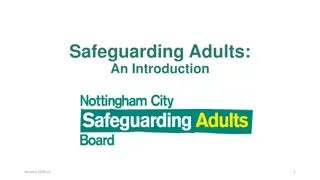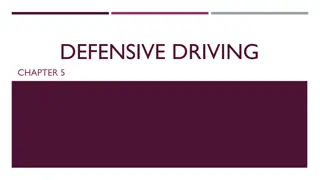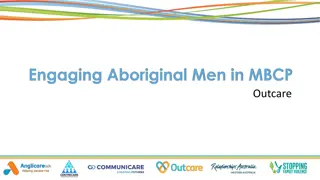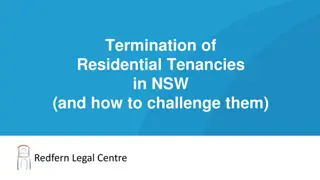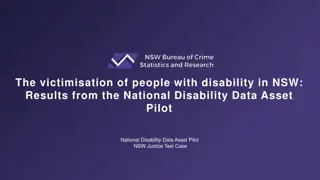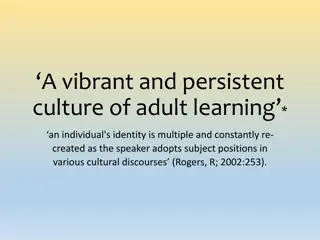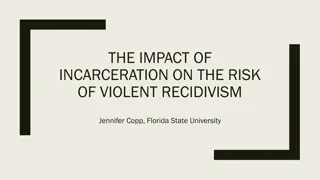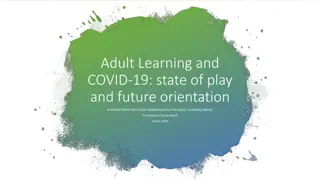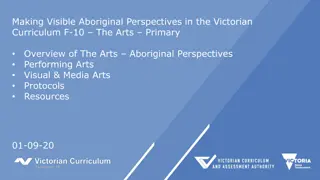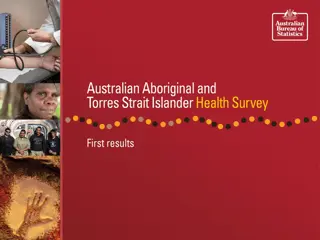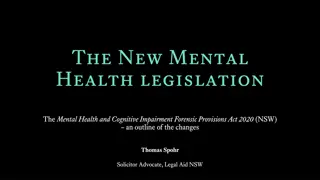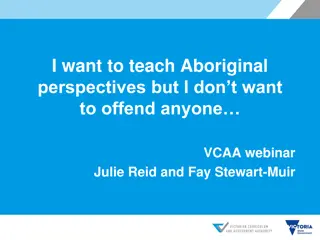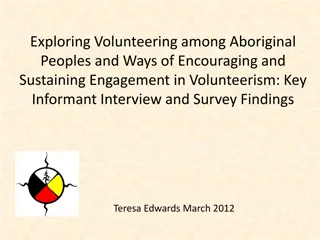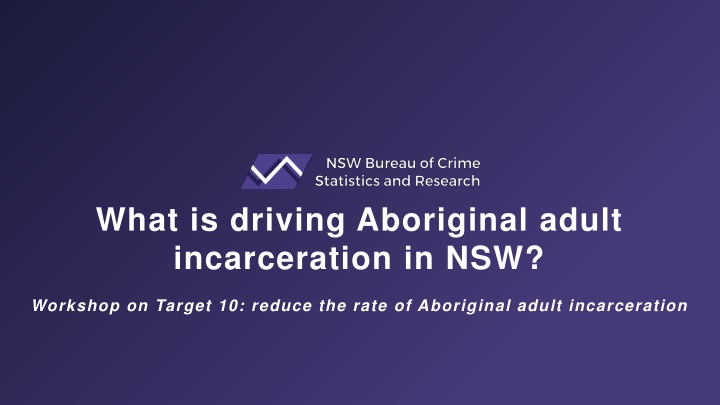
Drivers of Aboriginal Adult Incarceration in NSW
Explore the factors contributing to the high rate of Aboriginal adult incarceration in NSW, including trends in imprisonment rates, snapshot data of Aboriginal adults in custody, and targets for reducing incarceration rates as part of justice system reform efforts. This workshop highlights the need for intervention to address the underlying issues leading to disproportionate incarceration rates among Aboriginal individuals.
Download Presentation

Please find below an Image/Link to download the presentation.
The content on the website is provided AS IS for your information and personal use only. It may not be sold, licensed, or shared on other websites without obtaining consent from the author. If you encounter any issues during the download, it is possible that the publisher has removed the file from their server.
You are allowed to download the files provided on this website for personal or commercial use, subject to the condition that they are used lawfully. All files are the property of their respective owners.
The content on the website is provided AS IS for your information and personal use only. It may not be sold, licensed, or shared on other websites without obtaining consent from the author.
E N D
Presentation Transcript
What is driving Aboriginal adult incarceration in NSW? Workshop on Target 10: reduce the rate of Aboriginal adult incarceration
Justice system targets Adult incarceration Youth detention Domestic violence 13 10 11 By 2031, the rate of all forms of family violence and abuse against Aboriginal women and children is reduced at least by 50%, as progress towards zero By 2031, reduce the rate of Aboriginal young people (10-17 years) in detention by 30% By 2031, reduce the rate of Aboriginal* adults held in incarceration by at least 15% Targets 11 and 13 will be covered in a separate workshop Target 10 cannot be met without intervention Target 11 can be met with less intervention, as Aboriginal youth detention is trending down This presentation shows the drivers of adult incarceration leading up to Trends in domestic violence are included in this presentation as these are 2019 the reference year for the relevant to Target 10 targets^ 2 ^More recent data are less reliable due to the impact of the COVID-19 pandemic on the justice system. *Aboriginal includes Torres Strait Islander people
Trends in the rate of Aboriginal imprisonment Age standardised Imprisonment rate From 2006 to 2019 Aboriginal Imprisonment rate rose 39% Non-Aboriginal rate rose 15% 2,000 1,883 1,778 1,800 1,600 In 2019 Aboriginal adults were 12 times more likely to be in prison 1,353 1,400 1,200 1,000 From 2006 to 2019 Aboriginal female Imprisonment rate rose 29% Non-Aboriginal female rate rose 17% 800 600 400 181160 157 200 In 2019 Aboriginal Women were 16 times more likely to be in prison Aboriginal men were 9 times more likely to be in prison than women 0 2006 2007 2008 2009 2010 2011 2012 2013 2014 2015 2016 2017 2018 2019 2020 3 Aboriginal adults Non-Indigenous adults
Snapshot of the 3,650 Aboriginal adults in custody in Feb 2020 1 in 25 Aboriginal men are in prison 62% reoffend within a year 26% in Out of Home Care as a child 39% first custody episode before 18 60% reported at risk of serious harm as a child 66% prior DV offence 82% current drug problem 33% new custodial sentence within a year 92% prior custody episode 26% have a child in Out of Home Care 8 33% current alcohol problem 12 median prior custody episodes 66% didn t complete grade 10 median prior court appearances 13% diagnosed active psychosis 60% first court appearance before 18 9% Female 91% male 43% sentence length of a year or less 59% never been employed a full year 33 42% receiving mental health treatment 16 average age 30% moved residence 3+ times in a year median age at first court appearance 4
Target 10 in the NSW context Aboriginal adult incarceration rate per 100,000 2,488 2,600 Continuation of historical trend* - up 34% 2,400 10+ times the non-Aboriginal rate 2,200 2,000 1,855 1,855 2019 NSW incarceration rate 1,800 1,577 1,600 Closing the Gap target: reduce incarceration rate by 15% 1,400 1,200 1,000 2011 2013 2015 2017 2019 2021 2023 2025 2027 2029 2031 Projected NSW Aboriginal prison population - individuals 5,770 6,000 Continuation of historical trend* up 69% 5,000 4,300 25% of the total prison population 2019 NSW incarceration rate up 26% 4,000 3,419 3,660 3,000 Closing the Gap target: reduce incarceration rate by 15% 2,000 5 1,000 2011 2013 2015 2017 2019 2021 2023 2025 2027 2029 2031 *Unpublished statistical forecast based on trend in risk of imprisonment per population between 2006 and 2019
Summary: key drivers of Aboriginal adults in custody Increase in remand & bail breaches Prison population increasing High More violent & breach offenders More legal actions imprisonment rate The number of Court bail refusals rose by 40% Violent offences made up 75% of the increase in sentenced custody & 66% of the increase in remand (in 5 years) Some evidence of systemic bias Proven appearances rose 10%in 5 years, leading to more prison sentences Total population up 61% in 10 years Multiple and frequent contacts with the system from a young age compounded by socio economic factors Bail refusal rates also rose by 22% for Police and 11% for courts Remand is growing faster than sentenced custody: up 143%in 10 years Violent offending made up 27%of the increase in court volume and had relatively high imprisonment rates Justice procedure offences made up 27% of the growth in sentenced custody The volume of bail breaches established in court rose but the revocation rate fell Almost half of Aboriginal offenders reoffend within 6 months of release 6
Aboriginal adult prison population COVID-19 restrictions Share of total growth Sentenced 45% Change from Mar 2010 to Mar 2020: 3,666 Sentencing reforms Remand 55% Bail Act amendment (show cause) 3,368 Total population Up 61% 1,390 extra people New Bail Act 2,365 2,276 Sentenced Up 36% 625 extra people 2,220 1,740 1,301 Remand Up 143% 765 extra people 1,148 536 Mar qrt Mar qrt Mar qrt Mar qrt Mar qrt Mar qrt Mar qrt Mar qrt Mar qrt Mar qrt Mar qrt Dec qrt Dec qrt Dec qrt Dec qrt Dec qrt Dec qrt Dec qrt Dec qrt Dec qrt Dec qrt Dec qrt Sep qrt Sep qrt Sep qrt Sep qrt Sep qrt Sep qrt Sep qrt Sep qrt Sep qrt Sep qrt Sep qrt Jun qrt Jun qrt Jun qrt Jun qrt Jun qrt Jun qrt Jun qrt Jun qrt Jun qrt Jun qrt Jun qrt 7 2010 2011 2012 2013 2014 2015 2016 2017 2018 2019 2020
Summary: key drivers of Aboriginal adults in custody Increase in remand & bail breaches Prison population increasing High More violent & breach offenders More legal actions imprisonment rate The number of Court bail refusals rose by 40% Violent offences made up 75% of the increase in sentenced custody & 66% of the increase in remand (in 5 years) Some evidence of systemic bias Proven appearances rose 10%in 5 years, leading to more prison sentences Total population up 61% in 10 years Multiple and frequent contacts with the system from a young age compounded by socio economic factors Bail refusal rates also rose by 22% for Police and 11% for courts Remand is growing faster than sentenced custody: up 143%in 10 years Violent offending made up 27%of the increase in court volume and had relatively high imprisonment rates Justice procedure offences made up 27% of the growth in sentenced custody The volume of bail breaches established in court rose but the revocation rate fell Almost half of Aboriginal offenders reoffend within 6 months of release 8
Changing offence types in prison Aboriginal adult remand: top offences Change in offence mix, from 2015-2019 Violent Non-violent Assault 170 (Up 67%) Stalking/intimidation 50 (Up 227%) 241, Drug offences 43 (Up 96%) 183, Sexual assault 41 (Up 79%) Breach sentencing order 25 115, Theft 21 Weapons offences 107, 20 Robbery/extortion 19 92, Murder 17 Fraud 15 88, Dangerous driving 12 72, Break and Enter 10 50, Violent offences are a large and growing share of remand Of the remand population: 55% were for violent offences 29% for DV offences Over the 5 years to 2019: Two thirds of total growth was due to violent offences A further 10% was due to drug offences 9 Remand population Dec 2019: 1,191
Changing offence types in prison Aboriginal adult sentenced: top offences Change in offence mix, from 2015-2019 Assault 161 (Up 39%) Violent Non-violent Breach sentencing order 121 (Up 33%) 316, Sexual assault 69 (Up 48%) Dangerous driving 51 (Up 146%) 299, Stalking/intimidation 41 (Up 121%) Theft 27 263, Drug offences 27 Weapons offences 21 218, Fraud/deception 18 213, Murder 12 Public order offences -13 186, Robbery -22 Break & Enter -24 156, Traffic offences -42 127, Violent and breach offences represent a large share of sentenced custody Of the sentenced population: 44% were for violent offences (incl DV assault) 18% were for DV offences 20% were for breach of parole or community order In the 5 years to 2019: Nearly two thirds of growth was due to violent offences A quarter was due to sentencing order breaches 87, 86, 75, 10 Sentenced population Dec 2019: 2,312 74,
Summary: key drivers of Aboriginal adults in custody Increase in remand & bail breaches Prison population increasing High More violent & breach offenders More legal actions imprisonment rate The number of Court bail refusals rose by 40% Violent offences made up around two thirdsof the increase in sentenced custody & remand (in 5 years) Some evidence of systemic bias Proven appearances rose 10%in 5 years, leading to more prison sentences Total population up 61% in 10 years Multiple and frequent contacts with the system from a young age compounded by socio economic factors Bail refusal rates also rose by 22% for Police and 11% for courts Remand is growing faster than sentenced custody: up 143%in 10 years Violent offending made up 27%of the increase in court volume and had relatively high imprisonment rates Sentencing order breaches made up a quarterof the growth in sentenced custody The volume of bail breaches established in court rose but the revocation rate fell Almost half of Aboriginal offenders reoffend within 6 months of release 11
Court appearances Conviction & imprisonment rates Aboriginal court appearances Aboriginal proven appearances Conviction rate Imprisonment rate 90% 90% 90% 90% 89% 28,827 25,972 28,064 25,231 27,640 27,473 24,838 24,629 STABLE 25,079 22,369 21% 21% 21% 21% 19% 2015 2016 2017 2018 2019 2015 2016 2017 2018 2019 2015 2016 2017 2018 2019 Matters brought to court rose, increasing total convictions Change in court volume from 2015-2019: highest growing offence types in sentenced custody The rise in convictions was not due to changes in the conviction rate or imprisonment rate, both were stable Breach sentencing order 439 (up20%) Intimidation/stalking The six offences to the left were the top growing offences in sentenced custody, they also made up 37% of growth in proven court appearances 418 (up 39%) Non-DV Assault 177 (up 11%) DV Assault 172 (up 11%) Violent offences made up 27% of growth in proven appearances Dangerous driving 89 (up 22%) 12 Sexual assault 86 (up79%) Violent Non-violent
Offence types in court & prison sentences Aboriginal proven appearances 2019 Offences with high imprisonment rates have more influence on the prison population -110% -90% -70% -50% -30% -10% 10% Non-violent Violent 5% Traffic & vehicle 4,826 Theft & related 2,698 25% Traffic & illicit drug offences made up 29% of court appearances in 2019 but had low imprisonment rates Illicit drug offences 2,695 5% Breach sentencing order 2,649 15% Assault (no DV) 1,818 32% Assault (DV) 1,772 27% Violent offences have a proportionately high imprisonment rate, exerting more influence on the prison population than other offence types Breach of violence order 1,535 20% Intimidation/stalking 1,495 22% Public order offences 1,300 17% Property damage 989 9% Weapons offences 848 17% Break & enter 835 63% Justice procedure 807 20% Fraud 619 24% Dangerous driving 490 39% Note: all offences in the chart grew in volume from 2015 to 2019. Homicide and miscellaneous offences are not pictured as they both have small volumes in court and did not grow over the period. Robbery 262 81% 256 Abduction & harassment 33% 13 Sexual assault 195 71% - 1,000 2,000 3,000 % Imprisoned 4,000 5,000 6,000 Proven appearances (#)
Summary: key drivers of Aboriginal adults in custody Increase in remand & bail breaches Prison population increasing High More violent & breach offenders More legal actions imprisonment rate The number of Court bail refusals rose by 40% Violent offences made up around two thirdsof the increase in sentenced custody & remand (in 5 years) Some evidence of systemic bias Proven appearances rose 16%in 5 years, leading to more prison sentences Total population up 61% in 10 years Multiple and frequent contacts with the system from a young age compounded by socio economic factors Bail refusal rates also rose by 22% for Police and 11% for courts Remand is growing faster than sentenced custody: up 143%in 10 years Violent offending made up 27%of the increase in court volume and had relatively high imprisonment rates Sentencing order breaches made up a quarterof the growth in sentenced custody The volume of bail breaches established in court rose but the revocation rate fell Almost half of Aboriginal offenders reoffend within 6 months of release 14
Bail refusal volumes and rates Aboriginal bail decisions Aboriginal bail refusal rates 46.0% 42.4% 41.2% Police Bail refused Up 22% 38.8% 37.6% 10,019 Court Bail refused Up 11% 9,680 26.9% 26.0% 9,136 9,644 25.1% 24.4% 24.2% 9,214 2015 2016 2017 2018 2019 3,532 2,909 2,373 Bail refusal volumes & bail refusal rates were both up 2,262 1,982 The total number of bail decisions grew by 26% 4,997 4,228 4,032 3,838 The number of incidents where a person was police bail refused but court bail granted rose 78% 3,569 The rate of police and court bail refusals both increased 2015 2016 2017 2018 2019 Bail granted (up 9%) Police bail refused & court bail granted (up 78%) 15 Police bail refused & court bail refused (up 40%)
Bail breach and revocation Court bail revocations for Aboriginal adults Bail breaches established in court rose; most did not result in revocation 880 756 Most bail breaches did not result in revocation, the bail revocation rate fell from 2015-19 700 694 Revocation following technical breach (up 55%) 497 583 393 382 381 321 Where the breach involved a further offence, 46% resulted in revocation in 2019. Revocation following reoffence (up 45%) 382 364 320 315 263 2015 2016 2017 2018 2019 Bail breaches and revocations 45% Most common types of bail breaches established in court 41% 37% 40% 35% Further offence 830 35% 31% 31% 46% revoked Reporting 540 30% 2851 21% revoked 25% Curfew 318 29% revoked 2418 2004 20% 1865 No-contact 244 30% revoked 15% 1419 Residence 223 31% revoked 880 10% 756 700 694 583 5% Place restriction 196 A single bail breach incident can involve more than one breach category 33% revoked 16 0 0% Drug/Alcohol Restriction 143 2015 Bail breaches - up 101% 2016 2017 2018 2019 36% revoked Bail revocations - up 51% Bail revocations (%)
Proportionate impact of remand drivers 7% Reoffence revocations 2019 Remand 2015 Remand Technical breach revocations 10% 17% was due to increased bail revocations after breach Higher rate of court bail refusal 30% 1,723 more Aboriginal adults entered remand in 2019 than in 2015 Matters proceeded against to court 53% 83% of the rise was due to an increase in people bail refused 17
Summary: key drivers of Aboriginal adults in custody Increase in remand & bail breaches Prison population increasing High More violent & breach offenders More legal actions imprisonment rate The number of Court bail refusals rose by 40% Violent offences made up around two thirdsof the increase in sentenced custody & remand (in 5 years) Some evidence of systemic bias Proven appearances rose 16%in 5 years, leading to more prison sentences Total population up 61% in 10 years Multiple and frequent contacts with the system from a young age compounded by socio economic factors Bail refusal rates also rose by 22% for Police and 11% for courts Remand is growing faster than sentenced custody: up 143%in 10 years Violent offending made up 27%of the increase in court volume and had relatively high imprisonment rates Sentencing order breaches made up a quarterof the growth in sentenced custody The volume of bail breaches established in court rose but the revocation rate fell Almost half of Aboriginal offenders reoffend within 6 months of release 18
Why the Aboriginal imprisonment rate is so high 1. Extensive criminal histories of Aboriginal defendants Imprisonment rate, 2019 86% Any prior offences 59% 19% 9% 71% 3+ prior offences 38% 36% Prior prison 13% Non-Aboriginal adults Aboriginal adults Aboriginal Non-Aboriginal 2. Some evidence of racial bias in decision making Higher imprisonment rate, in part explained by prior contacts with the justice system Bail Aboriginal defendants more likely to be bail refused by Police than non-Aboriginal defendants (Klauzner and Yeong (2021) found a 2.8 percentage point difference) Aboriginal adults were more than twice as likely to be sentenced to prison in 2019. Aboriginal adults were also significantly more likely to have prior contact with the criminal justice system. Sentencing Aboriginal people 1 percentage point more likely to be imprisoned for serious assault after controlling for additional covariates (Thorburn and Weatherburn, 2018) BOCSAR research suggests potential systemic biases, but further work is needed. 19
Re-offending after release from custody Most common type of re-offence for Aboriginal adults Re-offending rate after release 2019 46% Theft 12.0% 41% Assault 10.1% 36% 30% Breach of violence orders 9.8% 30% 27% 22% Driving/licence offences 9.7% 23% 19% 11% Possess/use illicit drugs 9.2% 14% Note that the percentages presented are cumulative 7% Disorderly conduct 5.4% 1 2 3 4 5 6 Weapons offences 4.8% Months after release Aboriginal Non-Aboriginal Receive or handle proceeds of crime 4.7% Reoffending is common soon after release Breach of community-based order 4.4% Almost half (46%) of Aboriginal adults offend within 6 months of release from custody (compared to 30% of non-Aboriginal adults) The most common reoffence types are theft, assault, breach AVO, driving/licence offences and drug possession. Break and enter 4.3% 20 Intimidation/stalking 3.8%
Summary: key drivers of Aboriginal adults in custody Increase in remand & bail breaches Prison population increasing High More violent & breach offenders More legal actions imprisonment rate The number of Court bail refusals rose by 40% Violent offences made up around two thirdsof the increase in sentenced custody & remand (in 5 years) Some evidence of systemic bias Proven appearances rose 16%in 5 years, leading to more prison sentences Total population up 61% in 10 years Multiple and frequent contacts with the system from a young age compounded by socio economic factors Bail refusal rates also rose by 22% for Police and 11% for courts Remand is growing faster than sentenced custody: up 143%in 10 years Violent offending made up 27%of the increase in court volume and had relatively high imprisonment rates Sentencing order breaches made up a quarterof the growth in sentenced custody The volume of bail breaches established in court rose but the revocation rate fell Almost half of Aboriginal offenders reoffend within 6 months of release 21
Understanding the scale of the Adult target Projected NSW Aboriginal prison population Continuation of historical trend* 5,770 6000 5000 4,300 2031 population if current incarceration rate is maintained 4000 3,419 3,660 3000 Closing the Gap target 2000 1000 2011 2013 2015 2017 2019 2021 2023 2025 2027 2029 2031 Adult incarceration target By 2031, reduce the rate of Aboriginal adults held in incarceration by at least 15% In 2019 population terms, a reduction of 15% equates to approx. 500 prisoners 23 *Unpublished statistical forecast based on trend in risk of imprisonment per population between 2006 and 2019
Comparing the strength of different levers What we need to do per year to remove 50 Aboriginal adults from prison 10% of target reduction Share of annual volume Aboriginal adults Avoid 115 Break and Enter court actions per year = 10%of B&E matters Specific offences Avoid 430 DV assault court actions per year = 16%of DV assault matters TEXT Avoid 210non-DV assault court actions per year = 9%of non-DV assault matters Reoffending after prison Stop 380post-custody offending incidents per year = 16%of post-release offending Some offence types have very little direct impact on imprisonment Avoiding: ALL Goods in Custody court actions would only remove 30Aboriginal adults from custody ALL Drug Possession court actions would only remove 8Aboriginal adults from custody 24 Note: All analysis undertaken on an average basis, and outcomes should be taken as indicative. Custody impacts are estimated as average point in time (stock).
Comparing the strength of different levers Share of annual volume Aboriginal adults What we need to do per year to remove 50 Aboriginal adults from prison 10% of target reduction Court bail refuse 300fewer Aboriginal adults per year = 6%of Court bail refusals Bail Avoid 900 technical bail breaches per year = 60%of technical bail breaches TEXT = 1.4% of average custodial penalty length 3-4 day discount on custodial sentences for all Aboriginal adults Sentence 175 Aboriginal adults to anIntensive Correction Order instead of custody Sentence /court = 3.5% of custodial sentences Shift 220 matters from District Court to Local Court (i.e, Table offences reform Tranche 3 for some aggravated Break & Enter, aggravated robbery and drug supply offences) = 12%of District Court finalisations 25 Note: All analysis undertaken on an average basis, and outcomes should be taken as indicative. Custody impacts are estimated as average point in time (stock).
Potential levers Reducing entry into the justice system 1. 2. 3. 4. Reduce crime (specifically the highest contributors, like DV) Reduce arrests Divert from the justice system Better respond to risk factors (like mental health and drug use) Improving the justice system 1. 2. 3. 4. Redirect from remand to bail (e.g, focus on addressing recent increases in bail refusals) Reduce technical breaches of conditions on orders Alternative court processes and programs Faster court processes Sentencing 1. 2. 3. 4. 5. Reduce length of imprisonment Reduce short prison terms Improve community sentencing options Improve compliance with sentencing orders Reduce reoffending on community orders Custody and post-release 1. 2. 3. 4. 5. Reduce risk factors for offenders in prison Increase likelihood of parole Better use of time on parole Reduce returns to prison, focusing on pre-release planning and post-release supports Redirect to alternative places of detention or supervision 26



